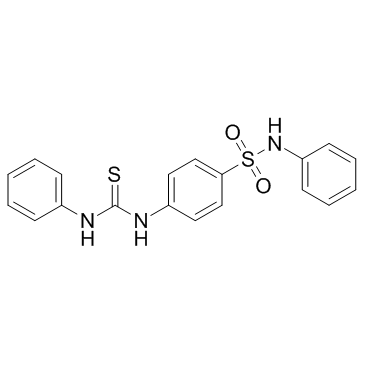LED209
Modify Date: 2025-08-25 12:40:13

LED209 structure
|
Common Name | LED209 | ||
|---|---|---|---|---|
| CAS Number | 245342-14-7 | Molecular Weight | 383.487 | |
| Density | 1.4±0.1 g/cm3 | Boiling Point | 549.4±60.0 °C at 760 mmHg | |
| Molecular Formula | C19H17N3O2S2 | Melting Point | N/A | |
| MSDS | N/A | Flash Point | 286.1±32.9 °C | |
Use of LED209LED209 is a potent small molecule inhibitor of bacterial receptor QseC, is a potent prodrug that is highly selective for QseC. Target: AntibacterialLED209 has desirable pharmacokinetics and does not present toxicity in vitro and in rodents. This is a unique antivirulence approach, with a proven broad-spectrum activity against multiple Gram-negative pathogens that cause mammalian infections.The LED209 QseC inhibitor has a unique mode of action by acting as a prodrug scaffold to deliver a warhead that allosterically modifies QseC, impeding virulence in several Gram-negative pathogens.[1] LED209 is QseC sensor kinase inhibitor , as a potential lead compound to combat infections with Legionella or Mycobacterium spp. [2] LED209 inhibits the binding of signals to QseC, preventing its autophosphorylation and consequently inhibiting QseC-mediated activation of virulence gene expression. LED209 inhibits EHEC virulence traits in vitro. LED209 markedly inhibits the virulence of several pathogens in animals. Inhibition of signaling offers a strategy for the development of broad-spectrum antimicrobial drugs. [3] |
| Name | 1-phenyl-3-[4-(phenylsulfamoyl)phenyl]thiourea |
|---|---|
| Synonym | More Synonyms |
| Description | LED209 is a potent small molecule inhibitor of bacterial receptor QseC, is a potent prodrug that is highly selective for QseC. Target: AntibacterialLED209 has desirable pharmacokinetics and does not present toxicity in vitro and in rodents. This is a unique antivirulence approach, with a proven broad-spectrum activity against multiple Gram-negative pathogens that cause mammalian infections.The LED209 QseC inhibitor has a unique mode of action by acting as a prodrug scaffold to deliver a warhead that allosterically modifies QseC, impeding virulence in several Gram-negative pathogens.[1] LED209 is QseC sensor kinase inhibitor , as a potential lead compound to combat infections with Legionella or Mycobacterium spp. [2] LED209 inhibits the binding of signals to QseC, preventing its autophosphorylation and consequently inhibiting QseC-mediated activation of virulence gene expression. LED209 inhibits EHEC virulence traits in vitro. LED209 markedly inhibits the virulence of several pathogens in animals. Inhibition of signaling offers a strategy for the development of broad-spectrum antimicrobial drugs. [3] |
|---|---|
| Related Catalog | |
| References |
| Density | 1.4±0.1 g/cm3 |
|---|---|
| Boiling Point | 549.4±60.0 °C at 760 mmHg |
| Molecular Formula | C19H17N3O2S2 |
| Molecular Weight | 383.487 |
| Flash Point | 286.1±32.9 °C |
| Exact Mass | 383.076202 |
| PSA | 110.70000 |
| LogP | 3.40 |
| Vapour Pressure | 0.0±1.5 mmHg at 25°C |
| Index of Refraction | 1.741 |
| InChIKey | HNDRSTUKPCLQLT-UHFFFAOYSA-N |
| SMILES | O=S(=O)(Nc1ccccc1)c1ccc(NC(=S)Nc2ccccc2)cc1 |
| Storage condition | 2-8℃ |
| LED209 hydrate |
| Benzenesulfonamide, N-phenyl-4-[[(phenylamino)thioxomethyl]amino]- |
| N-Phenyl-4-(3-phenylthioureido)benzenesulfonamide |
| N-Phenyl-4-[(phenylcarbamothioyl)amino]benzenesulfonamide |
| N-phenyl-4-[[(phenylamino)thioxomethyl]amino]benzenesulfonamide hydrate |
| LED209 |